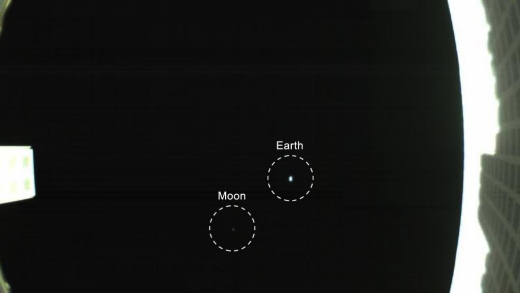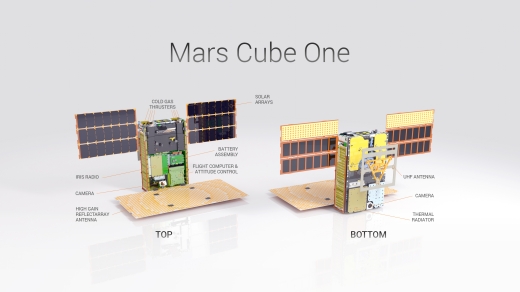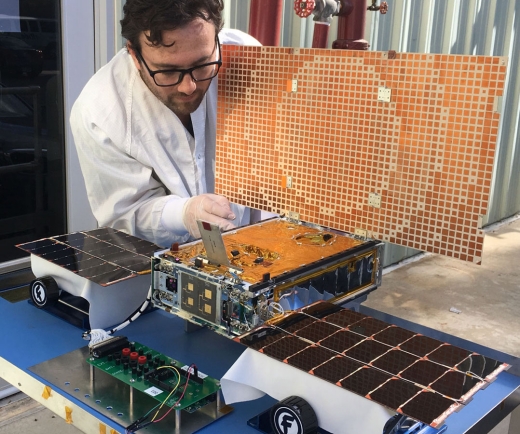The image below intrigues me. It’s the first image of the Earth and the Moon together taken from a CubeSat, one of a pair of such tiny spacecraft NASA has despatched to Mars as part of a mission called MarCO (Mars Cube One), which will work in conjunction with the InSight lander. Taken on May 9, the photo was part of the process of testing the CubeSat’s high-gain antenna. But to me it’s a reminder of how far miniaturized technologies continue to advance.

Image: The first image captured by one of NASA’s Mars Cube One (MarCO) CubeSats. The image, which shows both the CubeSat’s unfolded high-gain antenna at right and the Earth and its moon in the center, was acquired by MarCO-B on May 9. Credit: NASA/JPL-Caltech.
As of this morning, we are 66 days away from InSight’s landing on Mars, at a distance of 65 million kilometers from Earth and 16 million kilometers to Mars. I don’t usually focus on Mars and lunar missions because this site’s specialty is deep space, which for our purposes means Jupiter and beyond, and of course the overall theme here is interstellar. But experimental technologies that bring us greater performance from very small payloads are certainly relevant.
Anything we can do to shrink payload size pays off as we look at ever more distant targets, and the cruise velocities and propellant needed to reach them. And CubeSats are a way of exploring small payloads. The standard 10×10×11 cm basic CubeSat is a ‘one unit’ (1U) CubeSat, but larger platforms of 6U and 12U allow more complex missions. With fixed satellite body dimensions, the CubeSat format creates a highly modular and integrated system.
What we have with the two MarCO spacecraft is the application of what had been a low-Earth orbit satellite technology to a planetary mission, with a useful goal. Trailing InSight by thousands of kilometers, they’ve already demonstrated their ability to operate in the interplanetary environment. At Mars, the intention is for them to relay data on InSight’s landing, a job consigned to Mars orbiters, but one this mission may show CubeSats are able to perform.

Image: Illustration of one of the twin MarCO spacecraft with some key components labeled. Front cover is left out to show some internal components. Antennas and solar arrays are in deployed configuration. Credit: NASA/JPL-Caltech.
Each of the MarCOs has its own high-gain antenna and the necessary radio equipment for data relay, with propulsion systems that have already made two steering maneuvers enroute. No one would claim the diminutive space travelers are as complex as conventional interplanetary craft, but I can see two goals here, the first of which leverages the ‘traditional’ CubeSat role of acting as low-cost entry-level ways to reach orbit.
“Our hope is that MarCO could help democratize deep space,” said Jakob Van Zyl, director of the Solar System Exploration Directorate at NASA’s Jet Propulsion Laboratory in Pasadena, California. “The technology is cheap enough that you could envision countries entering space that weren’t players in the past. Even universities could do this.”
Fair enough, as we’ve learned how satellites can be ‘piggybacked’ to open up access to space, lowering launch costs even as the cost of the CubeSats offers opportunities for inexpensive missions. Moreover, the fact that CubeSats can be built with standardized parts and systems, with key components provided by commercial partners, underscores their efficiency.
But let’s move beyond today’s current CubeSat. If we can build these craft strong enough to handle relay operations from Mars, we can contemplate future CubeSats capable of a wider range of science return and consider propulsion technologies like solar sails for ‘swarm’ missions to targets beyond Mars. Of particular interest is coupling CubeSats with solar sails for propulsion. Remember, for example, The Planetary Society’s LightSail-1, launched in 2015, which demonstrated sail deployment despite a series of major software glitches.
LightSail-2 is designed to demonstrate controlled solar sailing in the CubeSat format, with a sail of 32 square meters. A key goal of this mission is to raise the orbit apogee after sail deployment at 720 kilometers. I should also mention LightSail-3, which could take this technology out to the L1 Lagrangian point, where it would remain to monitor geomagnetic activity on the Sun.
NASA’s own future plans for CubeSat work take in BioSentinel, which would take living yeast (S. cerevisiae) into space to study DNA lesions caused by energetic particles, with operations expected to last 18 months at distances well beyond low Earth orbit. The NEA (Near-Earth Asteroid) Scout mission would take a CubeSat/sail to a small asteroid, exploring its rotational properties, spectral class, regional morphology and regolith, while Lunar Flashlight would achieve lunar orbit to study ice deposits on the Moon for the use of future explorers.

Image: Engineer Joel Steinkraus uses sunlight to test the solar arrays on one of the Mars Cube One (MarCO) spacecraft. Credit: NASA/JPL-Caltech.
I might likewise mention such European Space Agency efforts as GOMX-3, a CubeSat mission exploring the telecommunications capabilities of such craft. GOMX-3 was deployed from the International Space Station in October of 2015 and operated for a year before re-entering the atmosphere.
The list of upcoming missions under ESA’s In-Orbit Demonstration is extensive (you can see it here), and it’s noteworthy that the agency inserts at the top of its list of potential applications the fact that CubeSats can serve “As a driver for drastic miniaturisation of systems, ‘systems-on-chips’, and totally new approach to packaging and integration, multi-functional structures, embedded propulsion.”
So we can keep an eye on the MarCOs as a harbinger of CubeSat operations to come. All three of the future NASA CubeSat missions I’ve mentioned are designed to be launched as secondary payloads on a future Space Launch System (SLS) mission. But however we get such missions into space, they point toward further exploration of small payloads, a parameter space Breakthrough Starshot is pushing to the max in its plans for a centimeter-sized, gram-scale payload to be driven by laser propulsion at 20 percent of lightspeed to another star.



“As of this morning, we are 66 days away from InSight’s landing on Mars, at a distance of 65 million kilometers from Earth and 16 million kilometers to Mars. ”
won’t MarCO burn up?
Both MarCO cubesats are on a flyby trajectory.
Although we often focus on the cutting edge, large space probes and satellites, Cubesats represent the “good enough” technology that is vastly cheaper for a range of tasks. Standard platforms, off-the-shelf components and OS software provide the economies of scale to reduce costs and development time, as well as being customizable.
We have started to see the availability of tiny, high Isp thrusters that can change these satellites’ orbits and even push them to escape velocity. I have to believe that deployable solar sails will become reliable, off-the-shelf components too. Swarms of satellites are good for monitoring the ground from orbit. At some point, I could imagine a swarm of CubeSats deployed around another planet to maintain continuous monitoring, rather than using a single probe that needs to use a tailored orbit to provide the repeat observations. Add components for roving, swimming, floating or flying, and these basic probes could deploy to cover many target locations, averting the need to find the “best”, often the safest target. That approach can afford to take risks and have unit failures for the best scientific gain.
If we ever get sensors and transmitters out to the gravitational focus of our sun, swarms of small CubeSats doing exoplanet imaging, radio SETI and even radio METI might be preferable to just one high cost, too-expensive-to-fail device.
Lastly, if we can build these small devices, so can ET. Which implies to me that we will not be able to detect such sensors monitoring Earth unless we are extremely lucky. Rather than a large probe that was speculated about by the visit of Oumuamua, I would expect swarms of tine probes capable of monitoring, yet small enough to be considered just random “clutter” should one be detected.
– Sara Seager in conversation with Lee Billings in “Five Billion Years of Solitude: The Search for Life among the Stars”.
That last chapter is a reminder that large projects, whether huge space telescopes or manned missions can die due to loss of commitment and funding. Doing small things cheaply can get results and make discoveries that stimulate further development. When instruments are cheap, it is possible to fail and iterate often, until success is achieved. This is the approach that software development has taken, casting aside the old “waterfall” method.
[The Asteria 3U CubeSat seems to be the result of Seager’s ideas and currently collecting data]
Seems like something similar is transforming the Comsat business. http://www.thespacereview.com/article/3570/1
Advanced ETI who bother to come to Earth could indeed examine us with very small high tech. In fact it makes a lot more sense than these reports of big ships with organic crews if they are serious about studying the denizens of Sol 3 scientifically without disrupting us.
Here are some examples courtesy of this blog:
https://centauri-dreams.org/2014/02/12/seti-at-the-particle-level/
https://centauri-dreams.org/2017/12/21/interstellar-communication-using-microbes-implications-for-seti/
“Japan space probe drops hopping rovers towards asteroid”
will use the low gravity environment to hop on the asteroid’s surface
A Japanese space probe Friday released a pair of exploring rovers towards an egg-shaped asteroid to collect mineral samples that may shed light on the origin of the solar system.
The “Hayabusa2” probe jettisoned the round, cookie tin-shaped robots toward the Ryugu astroid, according to the Japan Aerospace Exploration Agency (JAXA).
If the mission is successful, the rovers will conduct the world’s first moving, robotic observation of an asteroid surface.
Taking advantage of the asteroid’s low gravity, they will jump around on the surface—soaring as high as 15 metres (49 feet) and staying in the air for as long as 15 minutes—to survey the asteroid’s physical features with cameras and sensors….
https://phys.org/news/2018-09-japan-space-probe-rovers-asteroid.html#jCp
A few hours ago the robots landed successfully.
“this site’s specialty is deep space, … and of course the overall theme here is interstellar”. And indeed the journey of a “helluva lot” more than a thousand miles begins with a single step…
With modularity and assembly to fit the purpose, CubeSats and their ilk could become a standard around which exploratory systems are butlt. They’re a long way from von Neumann probes, but then again they could be a first step on that journey.
Great article! For your reading pleasure https://digitalcommons.usu.edu/smallsat/
Proceedings from the last USU SmallSat conference. Every year they grow in capability and “interplanetary cubesats” are here now with MarCo. Their vastly lower cost allows you to have more for the same budget and thus go to more places. Sending 1000 of these out is easily feasible on any typical launch vehicle (F9, Atlas V), especially if you can launch them enmasse in a general trajectory with the main launch vehicle and then they depart on their individual slightly divergent trajectories. Instead of constant data flow from them (which takes increasingly more power – have them burst data at established intervals). Imagine what sort of scouting you could do with these.
DARPA Funds $1.3 Million Study of Quantized Inertia (QI):
Has DARPA already test this with a CubeSat and knows that there is something really to it???
https://www.nextbigfuture.com/2018/09/darpa-funds-developing-quantized-inertia-into-breakthrough-space-propulsion.html?utm_source=dlvr.it&utm_medium=facebook
https://www.plymouth.ac.uk/news/scientists-receive-13-million-to-study-new-propulsion-idea-for-spacecraft
http://physicsfromtheedge.blogspot.com/2018/09/horizon-drives-quantum-rockets.html
http://earthsky.org/space/rocket-thrust-quantized-inertia-qi-darpa-funding
http://www.spacedaily.com/reports/Scientists_to_study_new_propulsion_idea_for_spacecraft_999.html
Fantastic to see an approach using quantum mechanics and relativity to formalise Mach’s principle and explain galactic rotation without resorting to ‘black magic matter’ and potentially explain the tentative results from Woodward and Em Drive.
Very interesting theory.
“The image below intrigues me. It’s the first image of the Earth and the Moon together taken from a CubeSat, one of a pair of such tiny spacecraft NASA has despatched to Mars as part of a mission called MarCO (Mars Cube One), which will work in conjunction with the InSight lander. Taken on May 9, the photo was part of the process of testing the CubeSat’s high-gain antenna. But to me it’s a reminder of how far miniaturized technologies continue to advance.”
I too am intrigued by the image above – but not for the reasons stated in the above paragraph. My reasons is that so many of the photographs that are taken from space probes are often altered or enlarged to bring out certain details and other aspects of the image.
I’ve always been much more intrigued by pictures that show the TRUE view that would be seen by the naked human eye. Far it is the naked human eye, which will someday gaze out of a spaceport window, without any optical enhancements, and take in the true scope of their immediate situation.
As an aside, I think that the image presented at the beginning of the article is extremely iconic in the fact that we have so few true images of what are place is in the vastness of space. Personally I would love to have a glossy color copy of exactly that particular photo. I think it would sell to the public at large.
Hopefully, CubeSats are the future. Gold plated $billion+ dollar spacecraft that take a decade to build are so inefficient.
Look what Space-X has done with launch vehicles! We need a new way of producing spacecraft.
Make 1U, 6U or 12U CubeSats and build ’em in “blocks” like the military does to incorporate improvements in ships and aircraft. We could get a lot more scientific return for the amount of money spent.
Yes, small machines can do wonders when it comes to exploring alien worlds – especially if those places are rather small themselves….
http://www.spaceflightinsider.com/organizations/jaxa/japan-successfully-lands-two-small-rovers-on-asteroid-ryugu/
https://apod.nasa.gov/apod/ap180924.html
How LightSail and a NASA study helped pave the way for Mars-bound CubeSats
Jason Davis
September 26, 2018
Two NASA CubeSats are approaching Mars — an impressive accomplishment for a concept many people regarded with derision just 15 years ago.
http://www.planetary.org/blogs/jason-davis/go-deep-space-cubesats.html
To quote:
CubeSats come in standardized sizes, the smallest of which is a 10-centimeter-per-side box weighing just a few kilograms. Thus far, they have been limited to Earth orbit; MarCO A and B are the first deep space CubeSats. It’s an impressive accomplishment for a concept many people regarded with derision when it debuted 15 years ago.
“I didn’t think that people would criticize it as much as they did,” said Bob Twiggs, co-creator of the CubeSat standard, in a 2014 Spaceflight Now interview. Twiggs, a Stanford engineer and professor who championed the idea with Cal Poly’s Jordi Puig-Suari, recalled people saying, “That’s the dumbest idea I’ve ever heard. Nobody’s going to use this toy.”
CubeSats were originally designed to give university students first-hand experience with space missions. And for many MarCO team members, that experience has paid off.
“As students, they messed around with CubeSats, when many people didn’t take CubeSats seriously,” said Joel Krajewski, the MarCO project manager at NASA’s Jet Propulsion Laboratory.
MarCO A and B are just the opening salvo of a new wave of CubeSats ready to conduct first-rate exploration beyond Earth orbit. In 2020, 13 CubeSats will hitch a ride to lunar space aboard the Space Launch System. More are in development for future planetary missions.
Review: Beyond Earth
For six decades, NASA and other agencies have been launching robotic missions beyond Earth orbit to study the solar system and the universe. Jeff Foust reviews a new NASA history that provides an overview of every one of those missions, successful or not.
Monday, October 8, 2018
http://thespacereview.com/article/3580/1
The first image of Mars by a CubeSat on its way to the Red Planet:
https://www.nasa.gov/image-feature/jpl/nasas-first-image-of-mars-from-a-cubesat